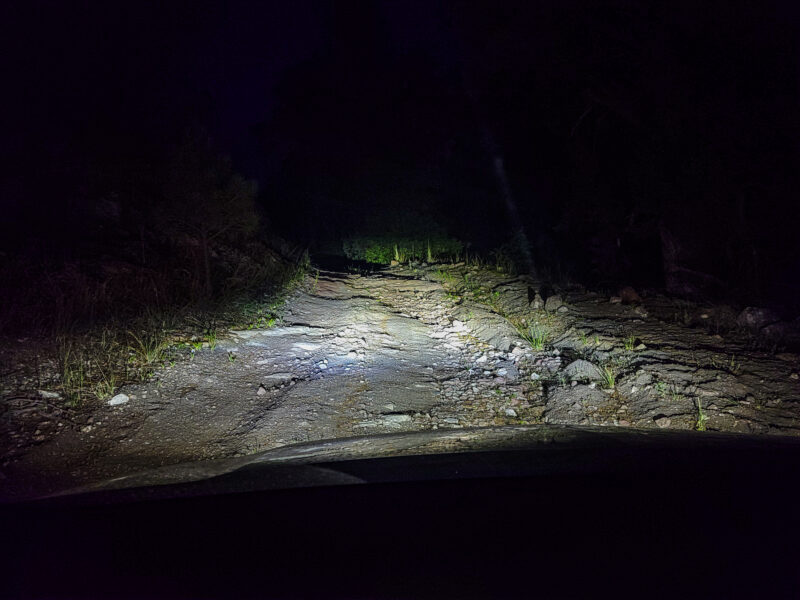
Over the weekend, I went on a fairly wild adventure in my Bolt EUV, which I call the “Bolt EAV.” Because I’ve outfitted it for adventures beyond what it was built for, I call it my Electric Adventure Vehicle. My brother asked me if we’d like to go with him to check out an abandoned mining town in New Mexico, and I decided it would be a worthy test. Perhaps more importantly, if I got in too deep, there’d be someone with 4-wheel drive to help pull me out.
Fortunately, I didn’t need that kind of help, and when I arrived at our destination, I found an extremely cool piece of cleantech history, one which I think qualifies as the granddaddy of the Tesla Powerwall!
The Journey Up
One of the tough things about going far from pavement is just how unpredictable things can get. Paved roads, whether at the interstate, state, or county level, are easy to rely on, because they’re durable and maintained. Occasionally a crazy weather event might take out a paved road, but that’s almost always something you hear about only on local media. The dirt roads that are closer to pavement are also pretty predictable, and get regular maintenance. The more established ones have gravel, and the cheaper ones at least get a blade dragged over them from time to time.
But, if you go a bit further, you can’t really know ahead of time what you’ll encounter, even if you’ve been there. Farther-flung county roads, ranch roads, and US Forest Service roads could be anything from a very nice gravel road to something you need a Jeep or Bronco to get through. You can sometimes find road descriptions or videos of the route, but often you can’t. Even Google Earth isn’t helpful, because a nice dirt road and one that’s in terrible shape both look like tan lines between greenery and rock outcroppings. Even if you know the place, a decent storm can radically transform the road in minutes.
In this case, the road went through that whole sequence and suckered me into doing things I probably wouldn’t have taken the EAV for had I known ahead of time. Leaving pavement, there were houses and small ranches along a well-maintained road. We crossed a cattle guard, and things got a little rougher, but were still very manageable. I’d have to dodge the occasional rock, but that was it. A couple of cattle-guards later, and we crossed into Forest Service land, and out of regular maintenance. Signs warned of a past burn scar and unpredictable conditions.
Things then got a lot harder. Most of the road was easy, but there were small patches on slopes that required me to go slow and pick a line carefully. Then, the ruts and holes got deeper. Loose material, which is normally mud this time of year, made for slipping front tires here and there, but the upgraded Michelin Defender LTX tires always grabbed and let the Bolt pull itself up.
Toward the end of the road, where dirt-bikes, side-by-sides, and true off-road vehicles typically only dare, I ran into the hard stuff. A few rocks scraped the underside of the battery pack (which isn’t worrisome, as modern EV battery packs are usually built from tough stuff to prevent fires), and I had to get a lot more choosy about lines, taking challenging segments very slowly, but rushing into others to keep up momentum.

Almost to the end of the road, I came across the gnarliest incline of the trip. I failed to get to the top, with two of the tires slipping into ruts on a left-hugging line. It’s a mistake I normally wouldn’t make, but I was distracted by a dog and then a child barfing in rapid succession (motion sickness). Fortunately, I had a seat cover, and we were able to quickly fold it up, put it in a trash bag, and get going again. On the second try, I picked a slightly smarter line approaching the rocks from the right and then crossing to the left, and with a little bit of slip-and-grip action, the Bolt pulled itself up and over the top.
From there, it was a couple hundred yards of smoother road, an easy creek crossing, and then the turnoff to the mine, which I missed because it was overgrown with grass. We got about 50 yards of semi-rough climb past the turnoff before we realized the mistake, which meant I’d need to either back down that climb or execute a 10-point turn.
On the second backup, I felt my hitch receiver hit dirt, but I pushed a little harder to see if I could get another foot or two to speed up the turn-around process. The hitch dug in deeper, but the front tires started slipping, and the front of the Bolt swung in the direction we needed to go. I didn’t look a gift horse in the mouth, and got back on the accelerator, and the continued slipping put the car in a position to require no more forward-and-back. I’d love to say I planned it that way, but it was still very satisfying!
I went back to the missed turn, went through a small dry stream, and then went up the driveway to the mining town. From here, the only thing in my way was a small fallen tree, which had rotted enough to simply snap off with a couple of swift kicks. Another hundred yards or so, and we started seeing remarkably well-preserved buildings, considering that the mine was reportedly abandoned over 50 years ago.
At this point, I came across the only incline the LTX tires weren’t grippy enough for, but it was just a way to get up next to one of the better-preserved buildings. Deep gravel, covered under a layer of grass, probably required all-wheel-drive and/or all-terrain tires, neither of which I have. I probably could have aired down, but everything was now in easy walking distance. So, I backed the vehicle down the hill into a clearing between other buildings, where we set up for dinner.
Exploring The Town
I had planned to cook and serve dinner, but everybody was too excited to explore the town in the fading light, so dinner would have to wait.
Some structures in the town were nearly completely collapsed, which was what I expected to find throughout the town. But, several of the buildings were in remarkably great condition. Some windows had been replaced with hastily-attached plexiglass, and most doors were still intact. What doors had failed were destroyed recently enough that the weather hadn’t gotten inside the building and destroyed the wooden structures inside.
But, it was also clear that desperate people had gotten there before us. Most of the copper wiring in the buildings had been stripped out, and just about anything else of any value had been carried away. What was left was basically just the shells of the buildings, some old TV sets, and random things that drug addicts had no use for. Strewn around the town was various mining equipment in various stages of rust and decay.
Strangely, several of the buildings had some remaining wiring and lighting, despite no power coming up the hill into the area from the grid. On the way up, we saw no signs of power lines or other utilities, and around the property, there were no utilities coming in from the outside. This place was off-grid, but the buildings clearly had power, which was weird. Some of the buildings had compact fluorescent “twisty bulbs” installed, so somebody had occupied the site around 2010 and abandoned it again, explaining the relatively good condition of the buildings.
What Powered The Town
Next to one building, I found something remarkable.

It was clearly a bunch of very old lead-acid batteries, like you’d find in a car or a tractor, but they were encased in some sort of resin or rubber compound to insulate them. Around the outside was some sort of concrete with embedded tabs for lifting, which had been done more recently with ropes. I also found two of these modules in a larger wooden box and several glass lids for each module broken on the ground.
These modules had been pulled out of a wooden building that had some wiring remaining and it was clearly the hub of energy distribution for the small mining town. On the back was what appeared to be a collapsed radio tower, with an antenna and something I couldn’t identify attached to the top of the fallen tower.
At first, I didn’t know what these were, but after getting home, I did some research and found out that it was a Jacobs Wind off-grid wind power system.
Many Rural Businesses Relied on Jacobs Wind, & Some Still Do
100 to 120 years ago, there were many places in the United States that had electric power. Big cities, small cities, and even many small towns had access to electric power because grid operators could turn a profit running shorter wires to a reasonable number of customers who could split the cost. The issue of rural electrification was eventually solved by a federal program (the Rural Electrification Agency) that helped create rural electricity co-ops.
Co-ops were great, because they provided cheaper electricity and included maintenance of the grid in the power bill, but that doesn’t mean rural farmers and ranchers, among other rural enterprises, simply did without power until a co-op ran them a long wire. They did what today’s off-grid enthusiasts, homesteaders, and RVers do: they turned to renewables.
My great-great uncle had a Jacobs Power system at his ranch in rural New Mexico, and like this one, the windmill and tower were located next to a small wooden building that housed the battery packs. Eventually, though, family lore is that the maintenance costs and work got out of hand (mostly replacing lead-acid batteries) and the family did without power sporadically again until the co-ops came to the area and offered a better deal.
But, rural co-ops didn’t always bring affordable power to every rural property. In some cases, truly remote properties like this little mining town were just too far away over extremely rugged terrain to get service, so they stayed with renewables over the long-term. In this case, it operated until around 1970 on wind power, possibly augmented by some hydroelectric from a stream that runs through it.
From Google Maps imagery, it seems that the rural buildings had some solar panels around 2015, but these had been removed since, so the property continued to rely on renewables and presumably at least some rudimentary storage during that period of habitation.

Comparing This To Today
Centralized power, like most other centralized things, is good from a financial perspective because making more power allows for economy of scale, and the savings can be shared among the customers in a wide area. But, just because something is economically viable doesn’t mean it’s good for the edge cases.
During power shortages we’ve seen both in California and Texas, the advantages of spending a bit more or doing something unusual to cover those edge cases become apparent. Not freezing to death is great, as is not losing power in a heatwave. Strains on electrical grids are bad for everybody in both cases, except people prepared to at least temporarily operate off-grid.
As we can see, renewables have long filled in where grid power just can’t work out. Whether it’s unusual weather, unusual geographic locations, or for other unusual needs (like RVing and camping), renewables can be there even when the grid struggles to help. So, we’re not looking at a new concept with things like the Tesla Powerwall, and companies like Jacobs Wind had lots of renewable energy history that came before them (especially hydroelectric and hydro-mechanical energy).
What’s sad is that we’re not preserving more of this history and tracing the roots of what we appreciate today. For this reason, I’m not going to disclose the location of what I found just yet, at least until I work with the Forest Service and others to make sure the little bit of history I came across gets better treatment.
All images by Jennifer Sensiba.
I don’t like paywalls. You don’t like paywalls. Who likes paywalls? Here at CleanTechnica, we implemented a limited paywall for a while, but it always felt wrong — and it was always tough to decide what we should put behind there. In theory, your most exclusive and best content goes behind a paywall. But then fewer people read it! We just don’t like paywalls, and so we’ve decided to ditch ours. Unfortunately, the media business is still a tough, cut-throat business with tiny margins. It’s a never-ending Olympic challenge to stay above water or even perhaps — gasp — grow. So …




